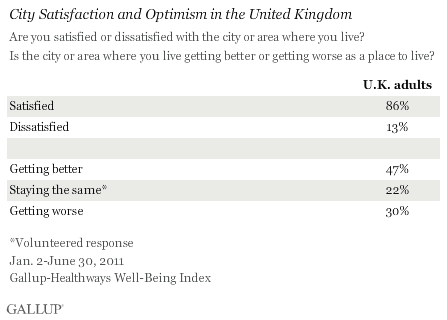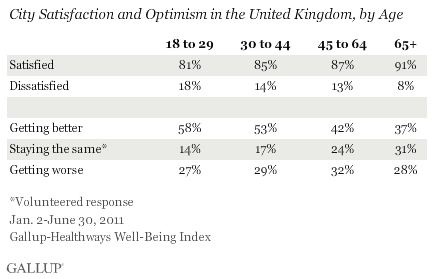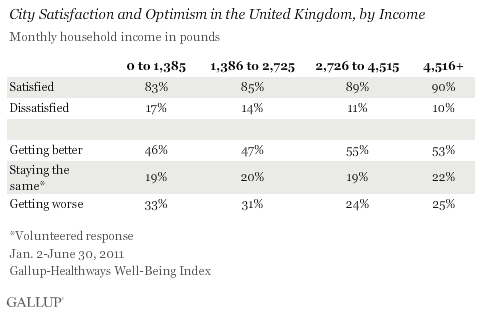WASHINGTON, D.C. -- Most Britons (86%) are satisfied with the city or area where they live. However, less than half (47%) say their city is getting better as a place to live, according to Gallup-Healthways Well-Being Index data, while 30% say it is getting worse.

Young Adults Less Satisfied but More Optimistic About Where They Live
Young adults in the U.K. are less satisfied but more optimistic about the city or area where they live than are older adults. More than 8 in 10 adults aged 18 to 29 say they are satisfied with the city or area they live in, slightly less than older adults who say the same. However, 58% of 18- to 29-year-olds say where they live is getting better -- significantly more than older Britons who the say the same, even after controlling for income. Older Britons aren't significantly more likely to say the city or area where they live is getting worse than younger Britons; they are more likely to say things are staying the same.

City Satisfaction and Optimism Among Income, Gender, Education Groups
Higher income Britons tend to be more satisfied with where they live than those in lower income groups, rising to 90% satisfaction among those earning 4,516 or more pounds monthly (equivalent to roughly $90,000 annually in U.S. dollars). Higher income Britons are also more likely to say that where they live is getting better. On both measures, however, the differences by income group are not large.

There are generally no differences in city satisfaction by education level or gender. However, city optimism does increase with education level.
Bottom Line
Closely monitoring resident perceptions of the community where they live is especially important for city leaders who seek to engage, retain, and attract residents.
Young adults' optimism about the future of their community is a positive sign for city leaders who seek to encourage young talent to move to and work in their areas. Leaders might also capitalize on that optimism by trying to engage young residents in local initiatives and projects. Seniors are no more pessimistic than young people; however, their dampened optimism remains a challenge for local leaders.
View all Gallup-Healthways Well-Being Index questions and methodology.
About the Gallup-Healthways Well-Being Index
The Gallup-Healthways Well-Being Index tracks U.S. and U.K. well-being and provides best-in-class solutions for a healthier world. To learn more, please visit well-beingindex.com.
Survey Methods
Results are based on telephone interviews conducted as part of the Gallup-Healthways Well-Being Index survey Jan. 2-June 30, 2011, with a random sample of 6,884 adults, aged 18 and older, living in the United Kingdom, selected using random-digit-dial sampling.
For results based on the total sample of national adults, one can say with 95% confidence that the maximum margin of sampling error is ±1.8 percentage points.
Interviews are conducted with respondents on landline telephones and cellular phones. Each daily sample includes a minimum quota of 5 cell phone respondents and 29 landline respondents, with additional minimum quotas among landline respondents for gender within regions. Landline respondents are chosen at random within each household on the basis of which member had the most recent birthday.
Samples are weighted by gender, age, education, region, adults in the household, and cell phone status. Demographic weighting targets are based on the most recently published population data from the Census Bureau for Northern Ireland, Scotland, England, and Wales. All reported margins of sampling error include the computed design effects for weighting and sample design.
In addition to sampling error, question wording and practical difficulties in conducting surveys can introduce error or bias into the findings of public opinion polls.
For more details on Gallup's polling methodology, visit www.gallup.com.
